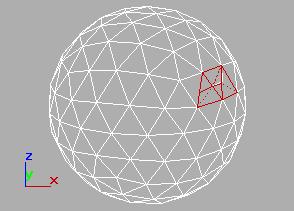Cut and Slice
Select an editable mesh object. > Modify panel > Selection rollout > (Optional: Choose a sub-object level.) > Edit Geometry rollout > Cut and Slice group box
The tools available in the Cut and Slice group let you subdivide edges and faces to create new vertices, edges, and faces. You can slice an editable mesh object at any sub-object level; the Cut tool is available at every sub-object level except the Vertex sub-object level.
Procedures
To create a new face using Cut:
-
Convert the geometry to an editable mesh.
-
 On the Modify panel, choose the object's Edge (or Face, Polygon, or Element) sub-object level.
On the Modify panel, choose the object's Edge (or Face, Polygon, or Element) sub-object level.
-
On the Selection rollout, turn on Ignore Backfacing.
-
On the Edit Geometry rollout, in the Cut and Slice group, click the Cut button.
-
Click the first edge you want to subdivide, and then move your cursor toward the second edge. The cursor changes to a plus sign when over an edge, and a dotted line connects the initial point where the edge was clicked with the current cursor location.
-
Click the second edge. This edge can be anywhere, cutting across as many faces as you like. A new visible edge appears.
-
At this point, a new dotted line is connected to the mouse cursor, originating from the last point you clicked.
-
Continue clicking edges to cut. To start from a different point, right-click, and then select the new start point. To finish cutting, right-click twice.


Before and after applying Cut to selected faces
You can use Snaps with Cut. To divide an edge in half, set Snaps to midpoint. To start or end a cut at a vertex, set snap to vertex or endpoint.
To create multiple slices:
-
Select an editable mesh.
-
 On the Modify panel, choose any sub-object level.
On the Modify panel, choose any sub-object level.
-
Select one or more sub-objects. Slice affects only selected sub-objects in face, poly, or element sub-object. No selection is necessary in edge or vertex sub-object.
-
In the Cut And Slice group box, click the Slice Plane button.
-
Position and rotate the Slice Plane gizmo to where you want the first slice.
-
Click the Slice button. The object is sliced.
-
If you want, move the Slice Plane to a second position and click the Slice button again.
-
Click the Slice Plane button again to turn it off and see the results.
-
To better understand what has happened, turn off Edges Only in the Display panel.

Slice gizmo placed for first slice (top) and second slice (bottom)
Interface
Note: The keyboard shortcuts listed here require that the Keyboard Shortcut Override Toggle be turned on.
Cut and Slice group

Slice Plane: Creates a gizmo for a slice plane that can be positioned and rotated where you want to slice the edges. Also enables the Slice button.
Slice: Performs the slice operation at the location of the slice plane. The Slice button is available only when the Slice Plane button is highlighted. This tool slices the mesh just like the Slice modifier in “Operate On: Face” mode.
Note: Slice works only on a sub-object selection. Make the selection before activating Slice Plane.
Cut: Lets you divide a edge at any point, then divide a second edge at any point, creating a new edge or edges between the two points. Clicking the first edge sets the first vertex. A dotted line tracks the cursor movement until you click a second edge. A new vertex is created at each edge division. Alternately, double-clicking an edge simply divides that edge at the point clicked, with invisible edges on either side.
You can use Cut to cut across any number of faces, even across an entire object. Click one edge to start the cut, and a second edge to end the cut.
Use Snaps with Cut for precision. Cut honors Midpoint, Endpoint, and Vertex snaps.
Important: When using the Cut tool to add new edges, you should work in a non-Perspective viewport, such as Front or User. If you use Cut while working in a Perspective viewport, you may find that the created edges appear to jump or aren't placed correctly. Using an orthogonal viewport will allow the cuts to appear where you click.
Split: When on, the Slice and Cut operations create double sets of vertices at the points where the edges are divided. This lets you easily delete the new faces to create holes, or animate the new faces as separate elements.
Refine Ends: When on, adjacent faces at the ends of the cut are also divided by additional vertices, so that the surface stays contiguous. When Refine Ends is off, the surface will have a seam where the new vertex meets the adjacent face. For this reason, it’s a good idea to keep Refine Ends turned on, unless you are sure that you don’t want the extra vertices created.
Refine Ends affects only Cut. It does not affect Slice.
Note: When performing a Cut, turn on Selection rollout > Ignore Backfacing to avoid accidentally selecting edges on the back side of the mesh.
 On the Modify panel, choose the object's Edge (or Face, Polygon, or Element) sub-object level.
On the Modify panel, choose the object's Edge (or Face, Polygon, or Element) sub-object level.



